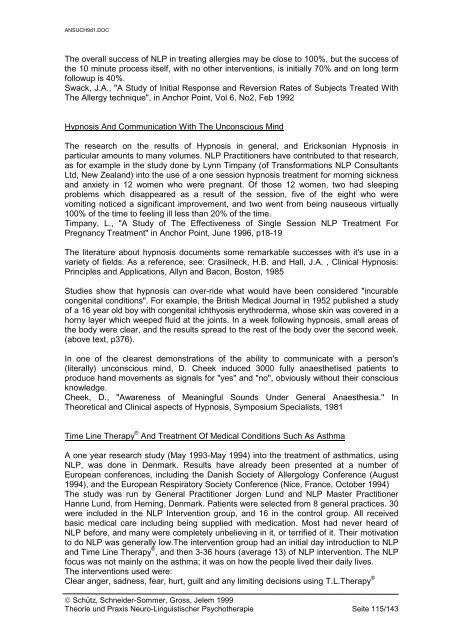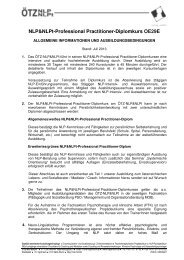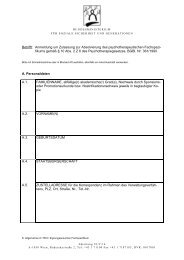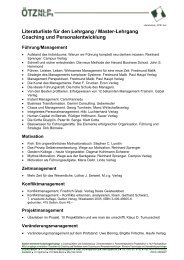AUSGANGSLAGE
AUSGANGSLAGE
AUSGANGSLAGE
Sie wollen auch ein ePaper? Erhöhen Sie die Reichweite Ihrer Titel.
YUMPU macht aus Druck-PDFs automatisch weboptimierte ePaper, die Google liebt.
ANSUCH9d1.DOC<br />
The overall success of NLP in treating allergies may be close to 100%, but the success of<br />
the 10 minute process itself, with no other interventions, is initially 70% and on long term<br />
followup is 40%.<br />
Swack, J.A., "A Study of Initial Response and Reversion Rates of Subjects Treated With<br />
The Allergy technique", in Anchor Point, Vol 6, No2, Feb 1992<br />
Hypnosis And Communication With The Unconscious Mind<br />
The research on the results of Hypnosis in general, and Ericksonian Hypnosis in<br />
particular amounts to many volumes. NLP Practitioners have contributed to that research,<br />
as for example in the study done by Lynn Timpany (of Transformations NLP Consultants<br />
Ltd, New Zealand) into the use of a one session hypnosis treatment for morning sickness<br />
and anxiety in 12 women who were pregnant. Of those 12 women, two had sleeping<br />
problems which disappeared as a result of the session, five of the eight who were<br />
vomiting noticed a significant improvement, and two went from being nauseous virtually<br />
100% of the time to feeling ill less than 20% of the time.<br />
Timpany, L., "A Study of The Effectiveness of Single Session NLP Treatment For<br />
Pregnancy Treatment" in Anchor Point, June 1996, p18-19<br />
The literature about hypnosis documents some remarkable successes with it's use in a<br />
variety of fields. As a reference, see: Crasilneck, H.B. and Hall, J.A. , Clinical Hypnosis:<br />
Principles and Applications, Allyn and Bacon, Boston, 1985<br />
Studies show that hypnosis can over-ride what would have been considered "incurable<br />
congenital conditions". For example, the British Medical Journal in 1952 published a study<br />
of a 16 year old boy with congenital ichthyosis erythroderma, whose skin was covered in a<br />
horny layer which weeped fluid at the joints. In a week following hypnosis, small areas of<br />
the body were clear, and the results spread to the rest of the body over the second week.<br />
(above text, p376).<br />
In one of the clearest demonstrations of the ability to communicate with a person's<br />
(literally) unconscious mind, D. Cheek induced 3000 fully anaesthetised patients to<br />
produce hand movements as signals for "yes" and "no", obviously without their conscious<br />
knowledge.<br />
Cheek, D., "Awareness of Meaningful Sounds Under General Anaesthesia." In<br />
Theoretical and Clinical aspects of Hypnosis, Symposium Specialists, 1981<br />
Time Line Therapy ® And Treatment Of Medical Conditions Such As Asthma<br />
A one year research study (May 1993-May 1994) into the treatment of asthmatics, using<br />
NLP, was done in Denmark. Results have already been presented at a number of<br />
European conferences, including the Danish Society of Allergology Conference (August<br />
1994), and the European Respiratory Society Conference (Nice, France, October 1994)<br />
The study was run by General Practitioner Jorgen Lund and NLP Master Practitioner<br />
Hanne Lund, from Herning, Denmark. Patients were selected from 8 general practices. 30<br />
were included in the NLP Intervention group, and 16 in the control group. All received<br />
basic medical care including being supplied with medication. Most had never heard of<br />
NLP before, and many were completely unbelieving in it, or terrified of it. Their motivation<br />
to do NLP was generally low.The intervention group had an initial day introduction to NLP<br />
and Time Line Therapy ® , and then 3-36 hours (average 13) of NLP intervention. The NLP<br />
focus was not mainly on the asthma; it was on how the people lived their daily lives.<br />
The interventions used were:<br />
Clear anger, sadness, fear, hurt, guilt and any limiting decisions using T.L.Therapy ®<br />
© Schütz, Schneider-Sommer, Gross, Jelem 1999<br />
Theorie und Praxis Neuro-Linguistischer Psychotherapie Seite 115/143






